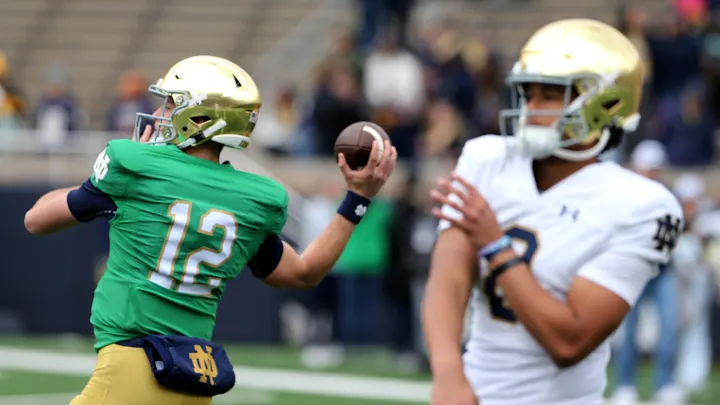Notre Dame’s Quarterback Dilemma: Exploring the Potential Impact of Starting Both CJ Carr and Kenny Minchey in 2025
As Notre Dame’s football program gears up for the upcoming season, the spotlight increasingly falls on the quarterback position—a critical role that could define the Fighting Irish’s success or struggles in 2025. With the depth chart evolving and the coaching staff showing interest in utilizing both CJ Carr and Kenny Minchey, fans and analysts alike are intrigued by the prospect of the Irish deploying a dual-quarterback system. This approach, though rare and often debated, could offer Notre Dame a unique strategic advantage, while also presenting challenges that must be carefully managed.
CJ Carr and Kenny Minchey are two very different players with distinct skill sets, yet both bring valuable attributes to the table. Carr, known for his strong arm and athleticism, possesses the ability to make plays both in and out of the pocket. His mobility allows him to extend plays and create opportunities downfield, making him a dynamic threat. Minchey, on the other hand, is often praised for his precision passing and calm demeanor under pressure. His decision-making and accuracy in the short to intermediate passing game provide a steadying influence on the offense. Combining these contrasting styles in a single game plan could force opposing defenses to prepare for multiple looks and potentially create mismatches.
Notre Dame’s coaching staff faces a unique challenge in determining how to best deploy these two quarterbacks without disrupting the offensive rhythm. Traditionally, most teams rely on a single starting quarterback to build continuity and leadership. However, given the talent and complementary skills of Carr and Minchey, experimenting with a two-quarterback system could be an innovative way to leverage their strengths while keeping defenses off balance. The key will be developing a game plan that integrates both players smoothly, maintaining offensive cohesion rather than causing confusion or disrupting momentum.
One possible approach could be using Carr in situations that demand explosive, vertical plays and designed quarterback runs, taking advantage of his athleticism and arm strength. Minchey could then be utilized in more traditional passing downs where accuracy, timing, and ball control are paramount. Rotating them based on game situations could also help keep both quarterbacks fresh, reducing the risk of injury over a long season. Furthermore, having two capable quarterbacks provides insurance in the event one gets injured or struggles with performance, ensuring the team can continue competing at a high level.
However, a dual-quarterback system also comes with inherent risks. The lack of a clear, consistent starter might lead to uncertainty among teammates, especially the offensive line and receivers who rely heavily on chemistry with their quarterback. The offensive coordinator must design plays that accommodate both quarterbacks without forcing the offense into rigid structures that reduce spontaneity or creativity. Additionally, managing egos and confidence levels will be essential; both Carr and Minchey need to feel valued and confident in their roles to perform at their best. The coaching staff’s ability to foster a supportive and competitive environment will be crucial in making this approach work.
The history of dual-quarterback systems in college football shows mixed results. Some teams have found success using two quarterbacks effectively, while others have struggled to maintain rhythm and leadership. Notre Dame’s situation is unique because both Carr and Minchey have shown the talent and versatility necessary to succeed at this level. If the coaching staff can harness their complementary skills and develop a cohesive strategy, the Fighting Irish could surprise opponents with their unpredictability and versatility.
In addition to the tactical implications, this quarterback competition could energize the team and fan base. A healthy rivalry between Carr and Minchey may push both players to elevate their games, fostering a culture of excellence and continuous improvement. Moreover, this situation reflects the broader trend in college football toward more dynamic, multi-dimensional offenses that prioritize versatility and adaptability. Notre Dame’s willingness to experiment with this approach demonstrates a forward-thinking mindset that could pay dividends in the increasingly competitive landscape of college football.
Looking ahead, the key for Notre Dame will be balancing innovation with tradition. The Fighting Irish have a storied football history, and maintaining a winning culture requires leadership, consistency, and clarity—qualities often embodied in a single starting quarterback. Yet, the evolving nature of the game demands flexibility and creativity. CJ Carr and Kenny Minchey represent the future of Notre Dame’s offense, and how the coaching staff manages this dual-threat situation will be a defining storyline of the 2025 season.
Ultimately, Notre Dame’s decision to potentially play both Carr and Minchey at quarterback could reshape the team’s offensive identity and strategy. By embracing the strengths of both players, the Fighting Irish might unlock new levels of offensive production and adaptability. However, success hinges on careful planning, effective communication, and strong leadership to ensure that this unconventional approach enhances rather than hinders the team’s overall performance. As the season approaches, all eyes will be on Notre Dame’s quarterbacks, eager to see how this exciting experiment unfolds on the gridiron.



